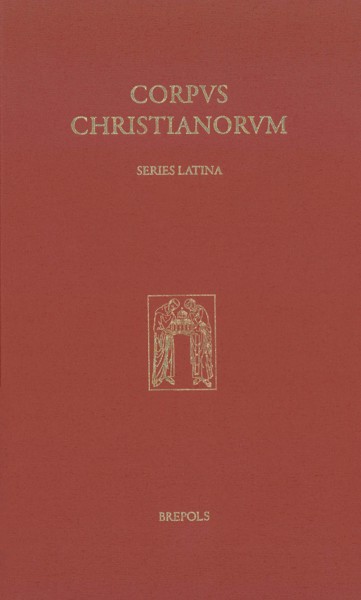
- Pages: 512 p.
- Size:155 x 245 mm
- Illustrations:137 b/w, 1 tables b/w.
- Language(s):Latin, Italian
- Publication Year:2022
- € 360,00 EXCL. VAT RETAIL PRICE
- ISBN: 978-2-503-59589-4
- Hardback
- Available
Genesis and afterlife of Cassiodorus’ influential synthesis of secular learning
“These points of detail in no way detract from the methodical and precise work carried out by [Ilaria Morresi] to provide access to the ΦΔ texts, an access now made more reliable by the extraordinary work carried out on these prolific traditions, which paved the way for Cassiodorus’ Carolingian continuators. Indeed, it was above all through their extended and expanded versions that Cassiodorus’ Institutiones became a key point of passage for antique knowledge to the medieval West.” (Anne Grondeux, on History and Philosophy of the Language Sciences, hiphilangsci.net; French version in Histoire Épistémologie Langage, 45-2, 2023, p. 233-238 [236])
« Œuvre massive, qui témoigne déjà d’une étude approfondie de la réception et de la transformation des Institutiones humanarum litterarum de Cassiodore, cette double publication [CC SL 99A & IPM 88] intéressera non seulement les spécialistes de cet auteur, ceux qui s’intéressent aux disciplines grammaticales et mathématiques et à l’enseignement dans l’Antiquité tardive et au Moyen Âge, mais devrait aussi retenir l’attention de tous les éditeurs de textes, en particulier lorsqu’ils sont confrontés à des traditions complexes et vivantes, qui ne se figent pas immédiatement dans un texte d’auteur. » (Matthieu Cassin, dans « Bulletin de patrologie », Revue des Sciences philosophiques et théologiques, 107-3, 2023, p. 573)
« On se réjouira de voir solidement confirmée une thèse difficile soutenue depuis Mynors et A. van de Vyver (...) et maintenant poursuivie jusque dans tous ses détails (liste exhaustive des témoins des deux recensions et stemma de chacune) et concrétisée dans une édition. Voici un nouvel instrument pour comprendre l’histoire de l’éducation au cours du VIIe et du VIIIe siècle. » (Pierre-Maurice Bogaert, dans Revue bénédictine, 133-2, 2023, p. 516-517)
“To sum up, this is an excellent piece of Late Latin scholarship. The knowledge of manuscripts, editions, stemmatics and previous literature is outstanding. From now on, every reader of Mynors’s edition should always have this book (and the complementary comment [IPM 88]) in the other hand.” (Álvaro Cancela Cilleruelo, in Bryn Mawr Classical Review 2024.03.25)
“Estamos, en definitiva, ante un trabajo editorial y filológico de alta factura, con el que la lectura crítica de las Institutiones de Casiodoro cobra una nueva dimensión. La suma del minucioso trabajo editorial aquí tratado y del exquisito comentario filológico de los textos que forman las redacciones interpoladas publicado casi contemporáneamente por Brepols [IPM 88] sienta las bases para que los estudios sobre las Institutiones en cualquiera de sus formas textuales puedan asistir a una nueva etapa de vigor renovado.” (David Paniagua, in Revista de Estudios Latinos, 24, 2024, p. 230-231)
“With the institutiones humanarum litterarum, Morresi presents a philologically thorough edition, in which she has mastered the challenge of breaking down the extremely complex transmission of two groups in detail and presenting it to the reader in one critical text. The more one tends to share the basic assumption, which ultimately goes back to Courcelle, that one is essentially still dealing with Cassiodorus’s first draft, the greater the benefit of this edition for understanding the earliest form of the text. But there can be no question that Morresi has produced an invaluable guide to the way the institutiones humanarum litterarum was read throughout the ages.” (Randolf Lukas, in Medievalia et humanistica, 50, 2025, p. 164-165)
Ilaria Morresi studied Latin Philology and Paleography at the Scuola Normale Superiore of Pisa, where she obtained a PhD in Sciences of Antiquity in 2019. She also graduated in Paleography and Archive Management at the Scuola Vaticana di Paleografia, Diplomatica e Archivistica in 2018, and is currently junior lecturer in Latin at La Sapienza University in Rome. Her main research interests include paleography, codicology, the circulation of texts in the early Middle Ages, and the medieval reception of ancient literature.
The Institutiones humanarum litterarum – that is, the second book of Cassiodorus’ masterpiece, devoted to secular learning – have come to us in three different textual forms: the ‘authentic’ recension Ω, corresponding to Cassiodorus’ final wishes, and two subsequent recensions, named Φ and Δ. Here, later interpolations were added starting from an earlier authorial draft, providing modern readers with valuable information about Cassiodorus’ progressive revisions and updates. Subsequent additions are also evidence of the early fortune of the Institutiones, showing which texts were actively read and studied from the 6th to the 9th centuries. Following Roger Mynors’ and Pierre Courcelle’s fundamental intuitions, Ilaria Morresi provides the first complete critical edition of the Φ Δ corpora, based on the systematic study of the manuscript tradition. Much attention is paid to the many diagrams included both within the Institutiones saeculares and the interpolations, which are clues to the great importance of images for Early Mediaeval teaching on Trivium and Quadrivium.
Premessa
Introduzione
I. Testo e redazioni
II. Tradizione manoscritta e stemmata codicum
III. Nota al testo
Bibliografia
Institutiones humanarum litterarum
Additamenta quae in textu II inueniuntur
Additamenta quae in textu III inueniuntur
Appendix Ω
Schemata quae in Humanarum litterarum institutionibus inueniuntur
Indices





